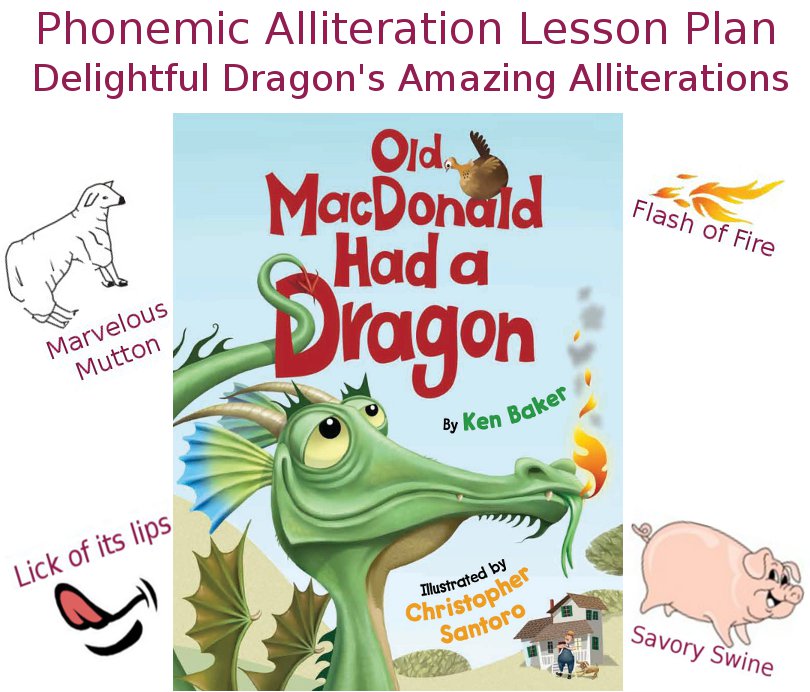Phonemic Alliteration lesson plan student level: PreK to 2nd grade elementary
Phonemic Alliteration lesson plan materials required:

Phonemic Alliteration lesson plan activity time: 30-90 minutes, depending on use of optional activities and reinforcement exercises. If all activities and exercises are used, the lesson can be divided into separate sessions if desired.
Objective of Phonemic Alliteration lesson plan: Help teachers achieve common core standards for phonological awareness by teaching students about alliteration and help students demonstrate an understanding of spoken words, syllables, and sounds (phonemes).
Preparation for Phonemic Alliteration lesson: Cut out the flashcard pictures from the Phonemic Alliteration Lesson Plan handout.
Introduction to Phonemes
In your own words, explain that words are made up of different sounds;
beginning sounds, middle sounds and ending sounds. For example, the word “red” has the beginning sound of “r”, its middle sound is “e” and
its ending sound is “d” (In each instance, say the letter and the sound it makes). Explain that when you combine all the different sounds
together, r-e-d sounds out the word “red”. Feel free to provide additional examples and explanations of word sounds and phonemes at
your discretion.
Optional activity:
Quiz the students on different beginning word sounds. Do this by holding up one at a time different pictures from the
handout’s phoneme flashcard pictures and then asking the students to identify the beginning word sound and the letter that makes the sound
for that word. Note: This activity can be conducted at this point in the lesson, later in the lesson to reinforce the understanding of
phonemes and beginning word sounds, or as a separate activity or lesson. If desired, you can also quiz the students on each word’s
middle and ending sounds.
Introduction to Alliteration
Next, explain that sometimes to make books more interesting or fun,
books will sometimes repeat words with the same beginning sounds. This
is called “alliteration”. An example of alliteration could be “fast
furry foxes fight ferrets”. Each word in this phrase starts with the
same beginning sound. Ask the students if they can tell you what the
beginning sound is for that phrase.
Optional activity:
Ask students to create their own alliteration
phrases by writing them down or sharing them aloud. For each example
they share, be sure to ask them to identify the words’ beginning sound
and letter.
Reinforce Students Students Understanding of Phonemes and Alliteration:
Tell the class that you're going to
read them a story and that as you read the story you want the students
to listen for times when alliteration is used. Tell the students that
you want them to raise their hand every time they think you’ve read a
phrase with alliteration in it. Read to the class the picture book, Old
MacDonald had a Dragon. (Note: Most of pages of the children’s book
have some form of alliteration (i.e., “delightful dairy”, “whipped its
wings”, “marvelous mutton”, “two-bit tune” and more).
After reading the story, ask the students if they can remember any of
the alliterative phrases from the story (Note: A few alliterative
phrases repeat through the book, such as “flash of fire” and “lick of
its lips”). Ask the students what the beginning sounds and letters are
for the alliterative words.
Assess Students Understanding of Phonemes and Alliteration: Re-read to the class the picture book Old MacDonald had a Dragon, asking the students to listen for alliterative phrases again. This time stop after reading any page with alliterative phrases and ask the students to identify the alliterative phrases. Ask the students what the beginning sounds and letters are for the alliterative words in these phrases, making any corrections or additional explanations as necessary. Continue reading the book and repeat this process for each page with alliterative phrases as desired.
Additional reinforcement and assessment – Writing Craft and Structure with Alliteration (Optional)
(Note:
This exercise can be conducted at the end of the lesson or as a follow-up exercise on another day)
Explain to the students that the way words and phrases are used in a
story, poem or song can enhance their meaning and rhythm. Rhymes,
repeated lines and alliteration are examples of ways that words and
phrases can be used to do this. Ask the students if they can remember
any repeated lines from the story Old MacDonald had a Dragon. Some
instances include “Old MacDonald had a farm, E-I-E-I-O”, and “Faster
than the farmer could sing “E-I-E-I-O”. There are also a few phrases
that repeat with subtle changes to them each time they repeat. Ask the
students how they think these repeating phrases help or improve the
story. Discuss with them what they like about the way these phrases are
used.
Ask the students to write their own short story, poem or song using
either alliteration, repeating lines or rhyme, or a combination of any
of the three. If desired, ask if any of the students would like to
share their story, poem or song.
To print this lesson plan: Download a printer-friendly PDF version of the Phonemic Alliteration Lesson Plan with handouts
Copyright 2001-2025 by Ken Baker
Heaven's Warrior cover by Ken Baker
Old MacDonald had a Dragon pictures by Christopher Santoro
Brave Little Monster pictures by Geoffrey Hayes
Cow Can't Sleep pictures by Steve Gray
How to Care for your T-Rex pictures by Dave Coverly